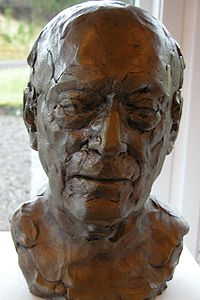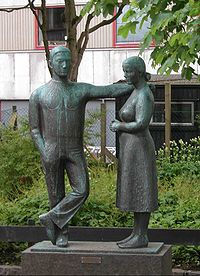
Janus Kamban
Encyclopedia


Faroe Islands
The Faroe Islands are an island group situated between the Norwegian Sea and the North Atlantic Ocean, approximately halfway between Scotland and Iceland. The Faroe Islands are a self-governing territory within the Kingdom of Denmark, along with Denmark proper and Greenland...
.
Kamban is the first and most important sculptor in the Faroe Islands. In 1930 he went to Copenhagen
Copenhagen
Copenhagen is the capital and largest city of Denmark, with an urban population of 1,199,224 and a metropolitan population of 1,930,260 . With the completion of the transnational Øresund Bridge in 2000, Copenhagen has become the centre of the increasingly integrating Øresund Region...
to the Royal Danish Academy of Fine Arts to study painting, but soon changed his direction and attended the School of Sculpture in the Art Academy from 1932 to 1935 and from 1938 to 1940, where he studied under Professor Einar Utzon-Frank
Einar Utzon-Frank
Aksel Einar Utzon-Frank was a Danish sculptor and professor at the Royal Danish Academy of Fine Arts. During his lifetime, he produced a large number of sculptures, many of which stand as public monuments...
. Study tours in the 1930s led him to Paris
Paris
Paris is the capital and largest city in France, situated on the river Seine, in northern France, at the heart of the Île-de-France region...
, Florence
Florence
Florence is the capital city of the Italian region of Tuscany and of the province of Florence. It is the most populous city in Tuscany, with approximately 370,000 inhabitants, expanding to over 1.5 million in the metropolitan area....
, Oslo
Oslo
Oslo is a municipality, as well as the capital and most populous city in Norway. As a municipality , it was established on 1 January 1838. Founded around 1048 by King Harald III of Norway, the city was largely destroyed by fire in 1624. The city was moved under the reign of Denmark–Norway's King...
and Stockholm
Stockholm
Stockholm is the capital and the largest city of Sweden and constitutes the most populated urban area in Scandinavia. Stockholm is the most populous city in Sweden, with a population of 851,155 in the municipality , 1.37 million in the urban area , and around 2.1 million in the metropolitan area...
.
In his Copenhagen studio he organized the first exhibition of Faroese Art in Denmark
Denmark
Denmark is a Scandinavian country in Northern Europe. The countries of Denmark and Greenland, as well as the Faroe Islands, constitute the Kingdom of Denmark . It is the southernmost of the Nordic countries, southwest of Sweden and south of Norway, and bordered to the south by Germany. Denmark...
. In addition to his own works, it included works by Gudmund Hentze, Sámal Joensen-Mikines
Sámal Joensen-Mikines
Sámuel Joensen-Mikines was a Faroese painter. He was the first recognised painter of the Faroe Islands and one of the Faroe Islands most important artists. Many of his paintings have been displayed on Faroese stamps....
, Elin Borg Lützen, Ruth Smith
Ruth Smith (artist)
Ruth Smith Nielsen was a Faroese artist. She lived for some years in Denmark, where she was educated as a painter first on the Bizzie Højer Art School and later on the Art Academy of Copenhagen...
and Ingolf Jacobsen.
During the Second World War
World War II
World War II, or the Second World War , was a global conflict lasting from 1939 to 1945, involving most of the world's nations—including all of the great powers—eventually forming two opposing military alliances: the Allies and the Axis...
he had to remain in German-occupied Denmark
Occupation of Denmark
Nazi Germany's occupation of Denmark began with Operation Weserübung on 9 April 1940, and lasted until German forces withdrew at the end of World War II following their surrender to the Allies on 5 May 1945. Contrary to the situation in other countries under German occupation, most Danish...
since the Faroe Islands were occupied by Britain
British occupation of the Faroe Islands in World War II
The British occupation of the Faroe Islands in World War II, also known as "Operation Valentine," was implemented immediately following the German invasion of Denmark and Norway....
. However, in August 1945, Kamban returned to the Faroe Islands on the first ship, the Aarhus. Once there, he immediately established himself as a sculptor.
His first monumental work was Móðurmálið (mother tongue), made in 1948 from local basalt
Basalt
Basalt is a common extrusive volcanic rock. It is usually grey to black and fine-grained due to rapid cooling of lava at the surface of a planet. It may be porphyritic containing larger crystals in a fine matrix, or vesicular, or frothy scoria. Unweathered basalt is black or grey...
, as an anniversary memorial for V U Hammershaimb
Venceslaus Ulricus Hammershaimb
Venceslaus Ulricus Hammershaimb was a Faroese Lutheran minister who established the modern orthography of Faroese, the language of the Faroe Islands, based on the Icelandic language, which like Faroese derives from Old Norse.-Background:Hammershaimb was born in Sandavágur on the island of Vágar in...
, 1846, creator of the Faroese written language. This monument is now hidden behind high bushes in Tórshavn.
However, the bronze bust for the politician and lawyer Niels Winther (1822-92) is clearly visible at the entrance to the national library, and the 3.8 x 2.9 metre cement relief Søgumaðurin (the storyteller) of 1956 can be seen on the facade of a local school in Tórshavn. Other monuments produced by him can be found all over the Faroe Islands, and his subjects are common everyday practical aspects of island life: seamen, islanders, sheep, pilot whale
Pilot whale
Pilot whales are cetaceans belonging to the genus Globicephala. There are two extant species, the long-finned pilot whale and the short-finned pilot whale . The two are not readily distinguished at sea and analysis of the skulls is the best way to tell the difference between them...
s, the Faroese chain dance
Faroese dance
The Faroese dance is the national chain dance of the Faroe Islands, accompanied by kvæði, the Faroese ballads.The dance is a mediaeval ring dance, which only survived in the Faroe Islands, while in other European countries it was banned by the church, due to its pagan origin...
and so on. He used plaster, cement, baked clay, wood, basalt and bronze
Bronze
Bronze is a metal alloy consisting primarily of copper, usually with tin as the main additive. It is hard and brittle, and it was particularly significant in antiquity, so much so that the Bronze Age was named after the metal...
. Two of his sculptures, Sheep with two lambs (cement, 1955) and Four whales (1986), are exhibited at the Faroese Art Museum.
In addition to his sculptures, he also produced graphics, particularly linocut
Linocut
Linocut is a printmaking technique, a variant of woodcut in which a sheet of linoleum is used for the relief surface. A design is cut into the linoleum surface with a sharp knife, V-shaped chisel or gouge, with the raised areas representing a reversal of the parts to show printed...
s, including numerous book illustrations, posters, logos and even three postage stamps.
Since 1970 he has lived in a house on the coast (Yviri við Strond in Tórshavn) with a view to Nólsoy
Nólsoy
Nólsoy is an island and village in central Faroe Islands, located to the east of the capital Tórshavn in Streymoy. There is only one settlement on the island: Nólsoy on the north-west coast on Stongin, a peninsula attached to the rest of the island by a metres-wide isthmus...
, built according to his specifications in the classical style, with black asphalt
Asphalt
Asphalt or , also known as bitumen, is a sticky, black and highly viscous liquid or semi-solid that is present in most crude petroleums and in some natural deposits, it is a substance classed as a pitch...
outside walls and grass roof. At the age of 85, he fell off his bicycle and broke his right hand and it has not healed properly, putting an end to his career as an artist.
Exhibitions
- 1935 Skulpturudstilling, CharlottenburgCharlottenburgCharlottenburg is a locality of Berlin within the borough of Charlottenburg-Wilmersdorf, named after Queen consort Sophia Charlotte...
- 1941 Skulpturudstilling, Haveselskabets Garden, FrederiksbergFrederiksbergFrederiksberg Kommune is a municipality on the island of Zealand in Denmark. It surrounded by the city of Copenhagen. The municipality, co-extensive with its seat, covers an area of and has a total population of 98,782 making it the smallest municipality in Denmark area-wise, the fifth most...
- 1943 Utzon-Frank and his students, Charlottenburg. 1943-45 Koloristerne
- 1948 Ólavsøkuframsýningin, Tórshavn, 1951-52, 1954-56, 1959-63, 1966-70, 1972-73, 1975-76, 1978, 1980-93
- 1970 Faroese Art, Bergens Kunstforening
- 1971 Art from the Faroes, Pier Art GalleryPier Art GalleryThe Pier Art Gallery in Stromness, Orkney, was opened to the public in 1979. The art collector Margaret Gardiner first visited Orkney in the 1950s and converted the old quayside building to house her collection of modern paintings and sculpture. It began as a personal collection of her friends'...
, Orkney - 1976 Faroese Art, the free exhibition, Copenhagen
- 1983 Grafiska Sællskapet, Malmø. Føroysk List, the Nordic Kunstcentrum, Helsingfors
- 1986 Faroese Art, Nikolaj Kirke Kbh.
- 1992 Várframsýningin, Tórshavn

